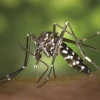In response to the recent outbreak of anthrax among livestock in several districts, the Department of Livestock Services (DLS), under the Ministry of Fisheries and Livestock, has launched emergency and coordinated actions to prevent and control the spread of the disease.
Anthrax is a bacterial zoonotic disease that can be transmitted from animals to humans. A strengthened vaccination campaign is set to begin shortly.
To contain its spread, local livestock offices—working in coordination with local administrations—have been conducting vaccination drives, health checks, courtyard meetings, awareness campaigns, leaflet distributions, and miking in affected areas.
The DLS has intensified awareness activities by publishing advertisements in national dailies and collaborating with local authorities.
Field-level monitoring in affected regions is ongoing, along with measures to prevent the slaughter of infected animals and ensure that all cattle in farms are vaccinated.
Under the “One Health” approach, the DLS is working jointly with the Directorate General of Health Services (DGHS) to raise public awareness.
Through courtyard meetings and training sessions, officials are advising farmers not to slaughter sick animals, not to dispose of carcasses in open areas or water bodies, but to bury them deeply, and to immediately contact nearby veterinary hospitals or livestock offices if any animal shows signs of illness.
Rangpur and Gaibandha districts have been identified as the most affected areas, where special vaccination programmes are being implemented.
The Livestock Research Institute (LRI) will soon supply around 3 million anthrax vaccine doses to the Rangpur Division, including 2 million doses allocated for Rangpur and Gaibandha alone.
In Rangpur district, 167,000 cattle have already been vaccinated across nine upazilas — Pirgachha (53,400), Kaunia (34,000), Rangpur Sadar (26,500), Mithapukur (34,500), Gangachara (4,800), Taraganj (4,300), Badarganj (5,000), and Pirganj (5,000). Courtyard meetings, roadshows, and training sessions have also been held to raise community awareness.
A total of 36 medical teams have been deployed at all 36 slaughterhouses in the district to ensure animal health inspections, while 32 teams are engaged in vaccination activities — 17 in Mithapukur, 8 in Pirgachha, and 7 in Kaunia.
In Gaibandha’s Sundarganj upazila, 26,400 cattle have been vaccinated. Preventive measures in affected areas include cattle burial, vaccination, miking, courtyard meetings, and leaflet distribution.
With the support of local administration, mobile courts have been conducted, collecting fines amounting to Tk 15,000, while five veterinary medical teams have been formed to monitor the situation.
Among 11 collected meat samples, 10 tested positive for anthrax, though all 11 blood samples tested negative.
Following directives from the ministry, the DLS has formed a high-level investigation team to assess the source and situation of anthrax infection in Rangpur and Gaibandha. The team will visit the affected areas and submit a detailed report soon.
Officials expressed optimism that with the joint efforts of the Ministry of Fisheries and Livestock, the DLS, local administrations, the health department, public representatives, and local communities, the spread of anthrax can be effectively contained.


 Prev Post :
Prev Post :
